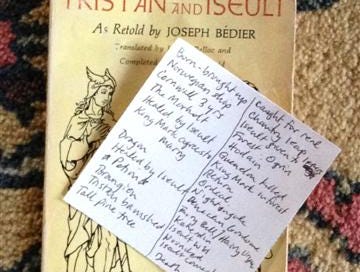In the mid 1990s, I picked up the paperback The Romance of Tristan and Iseult. Though it’s written in a formal manner, I was immediately drawn in. I could see the scenes in my mind’s eye. This was a story I wanted to tell to adults and older kids. But, sheesh, it’s loooooong!
At first, I told it in installments. I wasn’t sure I could handle such a long and intricate story. I wasn’t sure an audience would sit for it. I took a deep breath and tried it out.
My first full performance was two hours long. Yikes! The more I played with it, the more I understood which scenes were pivotal and which could be pared down or left out. It’s now about 70-80 minutes. That’s still lengthy. There is an intermission at about 50 minutes, more for me than for the audience, who have told me they didn’t need it.
One of my early performances of the story was just after 9/11. A listener told me what a relief it was to be pulled out of the real world and into the world of the story. In this tale, the audience goes into the story-listening trance. Everybody breathes together as we share a kind of dream space.
After another performance, a listener apologized for leaving abruptly at the end. She was with a friend who was sobbing and who needed to blow her nose. It is a tragedy, after all.
Here’s what I say in the program notes:
Tristan and Iseult: A Medieval Classic
An epic tale of good luck, bad choices, giants, dragons, fools, betrayal and of course, Romance.
Some stories are meant to last. Tristan and Iseult was first written down between 1160-1190 by Beroul (French poet) and around 1173 by Thomas of Britain, originally from the oral tradition, probably from a Celtic tale.
Sir Thomas Malory folded this story into the Arthurian legend, in Le morte d’Arthur (1469). Many other versions have been written and told in various languages and styles, including Wagner’s opera Tristan und Isolde.
As a storyteller, I perform without notes or script, with only the images in my mind to prompt me. I use Le roman de Tristan et Iseult by Joseph Bédier (1864-1938) as my base; there is a nicely readable translation by Hilaire Belloc, The romance of Tristan and Iseult.
I have taken liberties: some scenes are omitted, others expanded, and there are slight anachronisms, all in the service of the story. Stories live and change in the process of telling.
This story is the reason Liz Warren, Olga Loya and I began the now-defunct Going Deep Long Traditional Story Retreat, which could not have been done without the midwifery of Cynthia Changaris and Mary Hamilton, but that’s a subject for another post.
In 2022, I did a Zoom performance of Tristan and Iseult. Let me know if you’re interested in the recording—paid subscribers to this Substack will have access to it, and free subscribers can have access for $20.






I have attended your performance of this story on two occasions and would definitely recommend it.